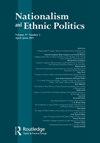内部敌人:第五纵队的全球政治
IF 1.1
Q3 ETHNIC STUDIES
引用次数: 0
摘要
俄罗斯和乌克兰身份之间的区别,弗拉基米尔·普京(Vladimir Putin)在科尔斯托(Kolstø)引用的一次演讲中表示;“乌克兰人可能喜欢或不喜欢,但我们是同一个民族”(第110页)。正是在这种背景下,Kolstø断言,必须理解乌克兰坚持独特的民族特性(临110)。从后见之明的角度来看,这本书的后半部分讲述了2014年的事件,为读者提供了一个出色的分析,说明克里米亚半岛被纳入俄罗斯联邦是如何开创了一个先例,许多俄罗斯人预计顿巴斯也会看到这种先例。俄罗斯政府随后无法复制重新划定的国界,这在民族主义圈子里引发了愤怒和恼怒。克里姆林宫似乎很可能无法控制局势,顿巴斯居民似乎决定了事态的发展,因此不清楚政府是否预测到了乌克兰东部冲突的爆发(第192页)。正如他所解释的那样,帝国主义和民族主义对国家的失望开始发展成更多的个人指责,不一定是针对普京本人,而是针对他周围的人(第202页)。Kolstø提到的Aleksandr Dugin甚至在社交媒体平台VKontakte上谈到了“背叛国家利益”,并建议普京的队伍中必须有“第六纵队”(第205页)。这次对克里米亚的调查意义重大,因为很容易将其与对2022年2月“特别行动”失败的类似反应相提并论。我们已经可以看到,精英们开始推卸责任,第五(或第六)纵队误导克里姆林宫的想法再次在公共话语中抬头。就像在克里米亚加入的后续行动中一样,公众动乱的出现可能不是因为反对“特别行动”,而是因为行动缺乏进展。Kolstø捕捉到的是,克里姆林宫政权“可能最终会像巫师的学徒一样,知道如何让扫帚取水——但不知道如何阻止它”(第216页)。因此,支撑这本书的思想是引人注目的,因为它们可以很容易地移植到新出现的情况中,特别是在后苏联时代迅速发展的事件中。随着摩尔多瓦的抗议活动和亚美尼亚与阿塞拜疆之间的重新战斗,这些想法和概念有可能在学术上的民族主义轨道上进一步发展。因此,对于任何对这个主题感兴趣的人来说,这本书都是必读的,看到Kolstø的工作在这个高度不稳定的地区取得进展将是很有趣的。本文章由计算机程序翻译,如有差异,请以英文原文为准。
Enemies Within: The Global Politics of Fifth Columns
ate a distinction between the Russian and Ukrainian identities, with the views of Vladimir Putin who in a speech quoted by Kolstø stated; “Ukrainians may like it or not, but we are one and the same people” (p.110). It is against this background Kolstø asserts that Ukrainian insistence on unique national identity must be understood (p.110). Given this perspective of hindsight, the latter half of the book addressing the events of 2014 provides the reader with an excellent analysis of how the inclusion of the Crimean peninsular into the Russian Federation set a precedent that many Russians anticipated to see replicated in Donbas. The Russian government’s subsequent inability to replicate the redrawing of national boundaries, led to anger and exasperation in nationalist circles. The Kremlin it seemed, was likely not in control of the situation, with the population of Donbas seemingly setting the pace of events, making it unclear whether the state had predicted the outbreak of conflict in east Ukraine (p.192). What developed, as he explains, was a situation where imperialist and ethnic nationalist frustration at the state, began to develop into more personal accusations, not necessarily levied at Putin himself but of those that surrounded him (p.202). Aleksandr Dugin as Kolstø refers, even talked of a “betrayal of national interests” on the social media platform VKontakte and suggested that there must be a “sixth column” in Putin’s ranks (p.205). This investigation into Crimea is significant as it is easy to draw parallels with similar reactions to failures in the February 2022 “special operation.” Already we can see elites beginning to apportion blame and the idea of a fifth (or sixth) column misleading the Kremlin has again reared its head in public discourse. Just as in the follow up to Crimean inclusion therefore there is the possibility that public unrest may appear not due to opposition to the “special operation” but due to its lack of progress. What Kolstø captures is that the Kremlin regime “might end up like the sorcerer’s apprentice, who knew how to make the broom fetch water – but not how to stop it” (p.216). The ideas underpinning this book are compelling therefore as they can be so easily transplanted to emerging situations, especially with events now moving rapidly in the post-Soviet sphere. With protests in Moldova and renewed fighting between Armenia and Azerbaijan, there is potential to develop on these ideas and concepts further on the tracks of nationalism in scholarship. This book is therefore a must read for anyone interested in the subject and it will be interesting to see Kolstø’s work moving forward in this highly volatile region.
求助全文
通过发布文献求助,成功后即可免费获取论文全文。
去求助
来源期刊

Nationalism and Ethnic Politics
ETHNIC STUDIES-
CiteScore
1.30
自引率
0.00%
发文量
30
期刊介绍:
Nationalism & Ethnic Politics explores the varied political aspects of nationalism and ethnicity in order to develop more constructive inter-group relations. The journal publishes case studies and comparative and theoretical analyses. It deals with pluralism, ethno-nationalism, irredentism, separatism, and related phenomena, and examines processes and theories of ethnic identity formation, mobilization, conflict and accommodation in the context of political development and "nation-building". The journal compares and contrasts state and community claims, and deal with such factors as citizenship, race, religion, economic development, immigration, language, and the international environment.
 求助内容:
求助内容: 应助结果提醒方式:
应助结果提醒方式:


